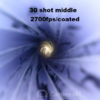The guy in the video either didn't have the temp right to cure the pc, didn't bake them long enough for the pc that he was using/thickness of the coating. Couple that with he's using a cheap thermoplastic pc that doesn't have any chemical resistant additives in it to cross-link to.
I use smoke's pc over on the castboolet website. Don't know who actually makes it. But I like the john deere green and have used it for years. Back in 2015 I wondered the same thing so I tossed pc'd bullets coated with jd green in 1# bottles of bullseye power pistol and am select. I left them in the 1# bottles for 6 months.
With the bullseye and power pistol the pc'd bullets started to loose their glossy look/shine. But the pc was still hard, the bullets passed the smash test.
The am select made the bullets dull looking also but not as much as the bullseye or powder pistol.
I have reloads from 2014 that I'm burning up that are loaded with pc'd bullets. They are stored in ammo cans & I haven't had any issues with weird smells, leading, fouling or anything else.
One thing I have done since day 1 was use extended cook times/cure times. Texas 10mm nailed it with his statement that the cure time starts when the powder melts. Cooking time can vary by the thickness of the pc. To long of a cooking time takes all the guess work out of the pc process. 2 years ago I started using a pid to control the temp the end result is an extremely consistent product.
Could it be the powder I'm using vs other brands is the reason I'm not experiencing pc breakdown??? Absolutely, but I personally think it has more to do with human error. This topic has had many posts/tests/reports done over the years over on castboolets. There doesn't seem to be a problem over there.
There are 2 types of pc, thermoplastic and thermoset.
Thermoplastic pc is cheaper to make and it's chemical composition is the same before and after baking. Typically it has no gloss or a vary basic gloss that doesn't have a lot depth to it visually.
Thermoset pc on the other had cross-links with either strait or any combination of polyester, polyurethane epoxy, strait epoxy or acrylics. These types of pc cross-link with the additives above improving the pc's durability along with being resistant to more types of chemicals.
Do a simple search on chemical resistant pc powers, you'll find that not all pc's are created equal.
The jd green I use that I get from smoke. The gloss of this pc has a lot of depth to it when looking at the bullets.

Even with the correct pc (thermosets) if it's not cured correctly it will no cross link and be chemical resistant. I use a cheap toaster over to pc with and was using a cheap $5 thermometer to set the temp with. I pc outside in a shed with the door cracked open. On windy days and the +/- 20 degree thermostat of the oven I'd get under cure at times. The bullets would pass the smash test but the pc would strip off the bullet when fired. It wouldn't build-up/foul the bbl I can only guess the next shot cleared the stripped pc. Recovered bullets with the pc missing from the bullet's body but still on the hp nose (poor man's smash test when hp expanded).

This is why I switched over to a pid, it controls the heat to +/- 2*
With these high performance pc coating I did run into an issue with the polymers not being able to withstand the head/friction of the hv/high pressure loads. I started getting black streaks in a 308w bbl when pushing the pc'd bullets 2700fps+.

I've seen this type of streaking before when using cheap wads for high performance shotgun loads using hot burning powders like bluedot. +/- 200 rounds on the trap range would produce black streaking like what's pictured above using (1990's) claybuster wads. Switchhed to ww wads and the streaks went away. The black streaks come right out with bore-tech eliminator and now when I simply tumble lube my pc'd rifle bullets with 45/45/10 (45% lee liquid lube/45% Johnson's paste wax/10% acetone). I've ran cast/pc'd bullets with the tumble lube over 3,000fps with no issues.
Anyway not all powder coating is created equal, nor is the cook times, heat/variations +/- of the different ovens to turn off or on. Couple that with human error. I can say that I use quality powders and have upgraded my equipment reducing errors in the baking process. I have no reason to worry about the chemicals in gunpowder degrading the pc. But then again my pc is applied correctly and it might also have something to do with the quality and type of pc I use.




